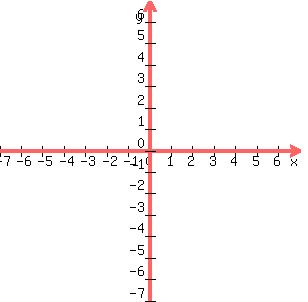Identify the axis of symmetry, create a suitable
table of values, then sketch the graph
(including the axis of symmetry).
y = x² + 3x 3
For the quadratic equation
y = Ax² + Bx + C the axis of symmetry has the
equation
x = -B/(2A)
In your problem,
y = x² + 3x 3,
A = -1, B = 3, C = -3, so the axis of symmetry has
the equation
x = -B/[2A]
x = -(3)/[2(-1)]
x = 3/2
First let's graph the axis of symmetry. We have
just one choice for x, namely 3/2. We just choose
arbitrary values for y, always choosing 3/2 for x,
and draw the graph of the the axis of symmetry:
AXIS OF SYMMETRY
x | y | (x,y) |
--------------------|
3/2 | 5 | (3/2, 5) |
3/2 | 3 | (3/2, 3) |
3/2 | -2 | (3/2,-2) |
3/2 | 6 | (3/2, 6) |
3/2 | -1 | (3/2, 1) |
3/2 | 4 | (3/2, 4) |
Those values for y are completely arbitrary!
Plotting these points and drawing through them
we get this graph, a vertical line
(Notice that 3/2 is just 1 and a half).
 Now we draw a graph of your quadratic equations:
y = x² + 3x 3
QUADRATIC EQUATION
x | y | (x,y) |
--------------------|
-1 | -7 | (-1,-7) |
0 | -3 | (0,-3) |
1 | -1 | (1,-1) |
2 | -1 | (2,-1) |
3 | -3 | (3,-3) |
4 | -7 | (4,-7) |
Now we plot those points and draw a
smooth (green) curve through them:
Now we draw a graph of your quadratic equations:
y = x² + 3x 3
QUADRATIC EQUATION
x | y | (x,y) |
--------------------|
-1 | -7 | (-1,-7) |
0 | -3 | (0,-3) |
1 | -1 | (1,-1) |
2 | -1 | (2,-1) |
3 | -3 | (3,-3) |
4 | -7 | (4,-7) |
Now we plot those points and draw a
smooth (green) curve through them:
 You will notice that the graph of the axis of
symmetry, which is the red vertical line,
bisects the green graph into two symmetrical
halves.
Edwin McCravy
You will notice that the graph of the axis of
symmetry, which is the red vertical line,
bisects the green graph into two symmetrical
halves.
Edwin McCravy